Comparing Hoka vs ASICS running shoes could largely be described as a difference in fit and feel, along with some company philosophy if you care about those things. But of course we know that Hoka came on the scene due to their maximal shoes and that’s interesting all on its own!
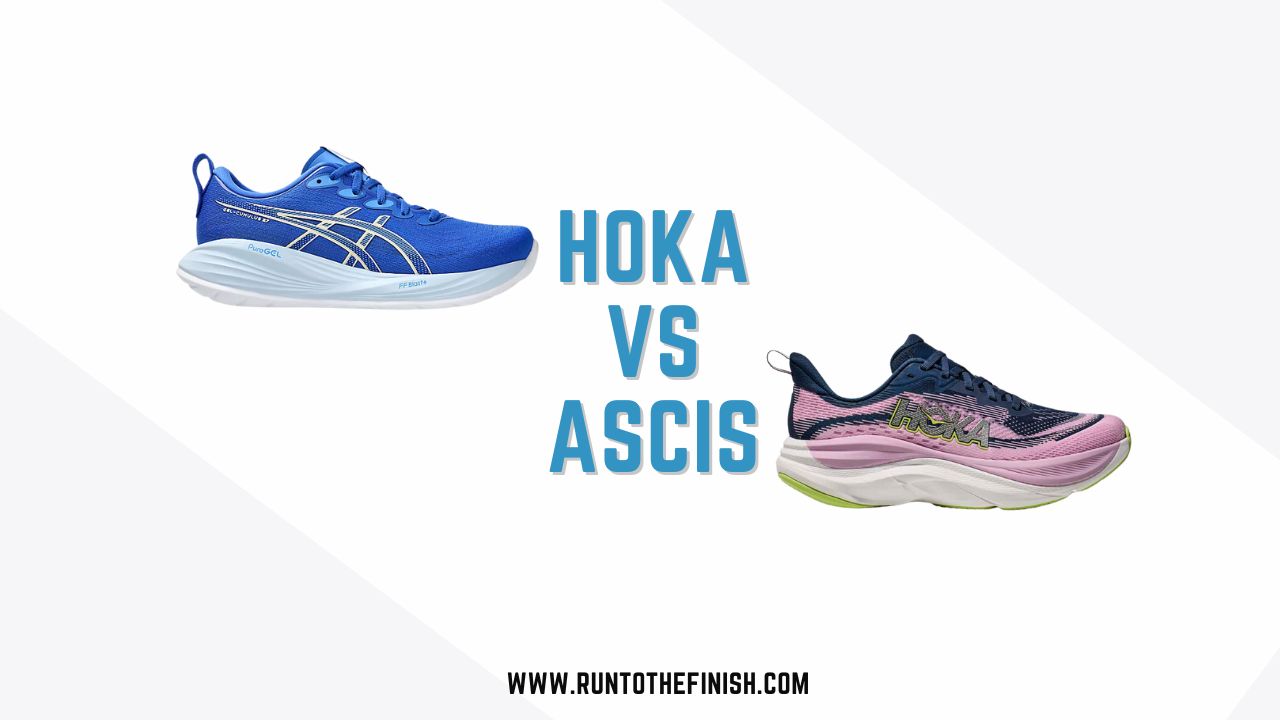
Especially because in the last few years, more brands are jumping on this trend to add more cushion to their shoes without adding weight! Now maybe it’s not so different to have that big stack height.
Both brands provide high quality shoes and offer a variety of models to suit different needs like overpronation, cushioning, and trail running.
Hoka One One first became popular with Ultrarunners and has since moved in the to main stream of running. I myself have run in a number of models and previously compared all running shoe Hoka styles. Meanwhile, in over 20 years of running I’ve also been through a lot of Asics!
Hoka Vs ASICS Key Differences
Asics and Hoka offer similar features and models for all kinds of runners, from the new runner to Ultramarathoner to the flat-footed or high-arched.
Largely we’re looking at how a maximal shoes compares to a traditional running shoe.
I break down the differences in more detail below, but here’s a quick overview:
Hoka Running Shoes
- Maximal shoe – has the larger sole for stability and smooth ride
- Usually more cushioned
- Some state they run narrow, but compared to other brands like Nike I disagree
- Does have some casual shoes, gym shoes and recovery sandals
ASICS Running Shoes
- More narrow fit, especially in the heel and midsole
- Famous for its GEL technology, which provides shock absorption
- Seems focused on shoes to prevent injury
- Designs a variety of shoes for many different sports
I’ve worn both brands and will add some personal thoughts, along with links to detailed reviews.
If you’re looking for other comparisons, checkout ASICS Vs Mizuno or Hoka vs On Cloud or Hoka Vs Saucony.
ASICS vs HOKA ONE ONE Feature Comparison
Both brands have been around for a very long time and are leaders in running shoe design. They both offer various technologies to aid with comfort, support, stability, and cushion. Where they differ most are in the fit.
The following breaks down each shoe based on the components buyers need to consider when purchasing a running shoe.
It’s gonna get a little TECHY…so you can just skip on down to the specific model comparison if you want, but personally if I’m shelling out $150 for shoes, I kinda want to know why.
Durability
The lifespan of shoes from both companies is fairly comparable.
- ASICS recommends swapping out for new shoes every 450 to 500 miles.
- HOKA is often reported to last longer. I don’t know if this is more trail runners and thus less hard surfaces which extends the life of the shoe or simply their maximal design.
Determining when to replace running shoes, of course, all depends on your gait, weight, and whether you run mostly on trail or road.
Fit
ASICS shoes have a more snug fit, particularly in the heel and midfoot. An external heel clutch delivers targeted fit and support, while the Gel technology allows for foot movement in various directions as the foot transitions, reducing heel strike.
While ASICS also features a shoe fit guide, it takes a little sleuthing to find (you’re welcome).
HOKA shoes run true to size from my testing. Some models are definitely a little more narrow than others, as with most brands. In fact, they have been working on increasing the toebox in newer models.
They also have a shoe finder quiz to help you get in to the right model.
👉Checkout this guide on How to Lace Running Shoes, you’ll be amazed at how you can make most shoes fit better!
Cushioning
ASICS uses Flytefoam technology that provides bounceback and responsiveness with each step. It gives a bit less energy return than say Brooks shoes, but the two technologies are fairly similar.
The company has been using their famous Gel technology for more than 30 years. It works well to absorb the shock with each step.
HOKA likes to say they provide marshmallow softness. More technically PROFLY.
I’m going to admit that I was really skeptical of HOKA at the start because I assumed all that cushion would make it heavy. It turned out I was wrong and instead have been running in them since of their very first shoes.
- They have 3 levels of cushion, which is important because plush isn’t what you want on all runs
- Cushion that provides both a good landing and plenty of stability for push off
- Hubble Heel – their newest shoes with a longer heel which is supposed to improve heel to toe transition

Stability
ASICS shoes provide stability through a dual density midsole system called Duomax, which enhances support and stability. That, along with the external heel clutch allow the foot to continue its natural movement while running.
HOKA was designed entirely with stability in mind.
It was a core foundation of their shoes because it allows runners to move quicker with less risk of injury. This is why they created a wide stable platform.
In fact, they call their heel system the “bucket seat”, like the seat of a race car. It cushions the heel and foot without posts or guide rails — this means the midsole remains more cushioned.

Overview of heel to toe drop and type of cushion in most shoe brands.
Affordability
The prices between the two brands are fairly comparable. ASICS prices range between $110 to $160, while HOKA’s start at a slightly higher price at $120 to $250.
The most popular models for ASICS are around $150 and for HOKA also around $150. Specialty items with more features (like carbon plates) will increase price.
You’ll notice that every brand offers a range and this is indeed due to a difference in technology and where they sell the shoe. They know that the big box store can sell the shoe with less in it, while the local running store needs to be best for dedicated runners.
HOKA Vs ASICS Models
Now that you know more about each brand, let’s look at their top models in each of the main categories. There’s no winner declared here because all are great shoes, it’s just about which one is best for your foot.
With each of these, they are the top models so numbers are constantly changing as they make a little upgrade and it becomes the Kayano 31 or the Bondi 9.
Stability Running Shoe
👉ASICS GEL Kayano
The GEL Kayano is now in its 31st iteration and known as one of the best stability shoes on the market. Great for overpronators seeking stability, the GEL Kayano is an ideal shoe for marathons.
It’s more cushioned than most stability shoes and thus has remained a favorite of many runners for a very long time. To be clear, it’s not that plush max cushion feel, but a moderate underfoot feel that allows for pronation correction.
The fit is in line with most shoes, but you will notice a bit more of a heel lock. This is again to help with that foot pronation without over correcting.
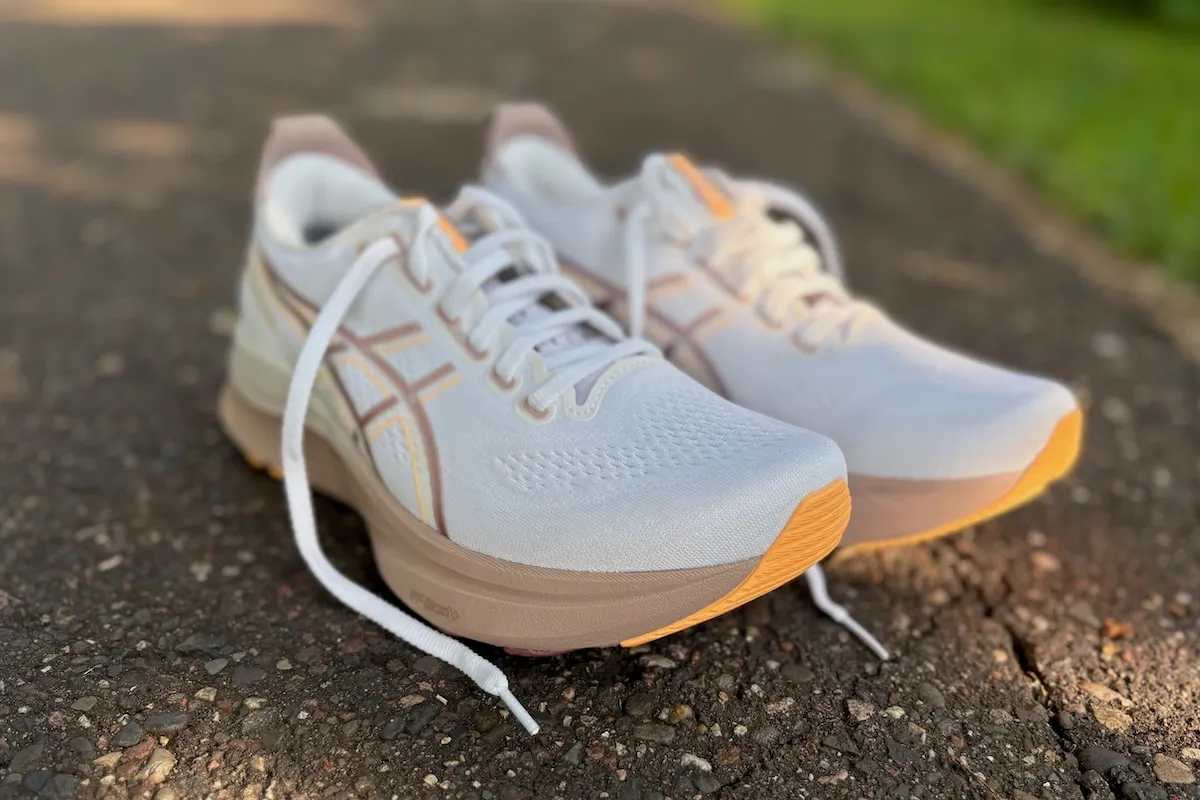
- Weight: 10.7 oz Men’s, 9.1 oz Women’s
- Stack Height: 40 mm
- Heel Drop: 8 mm
- Available in nine colors
- Available in wide and narrow
- Available at Asics.com for $165.00
- Read our full review of the Asics Gel-Kayano 32 here >>
👉 HOKA Arahi
Softer and more flexible than your usual stability shoe, the Hoka Arahi 8 maintains a solid sense of balance throughout the shoe while allowing for a smooth and comfortable ride.
It’s not the fastest shoe, but if you’re putting on the miles in training or heading out for a long run, this will be a great shoe to grab for.
One big upgrade from the previous models is the support system Hoka opted for, switching from J-Frame stability to H-Frame stability technology.
This shifted the support from just the medial side (or inside) of the foot to both the medial and lateral sides allows the shoe to keep the material directly under the forefoot and heel making it a more balanced and less stiff ride, great for overpronators.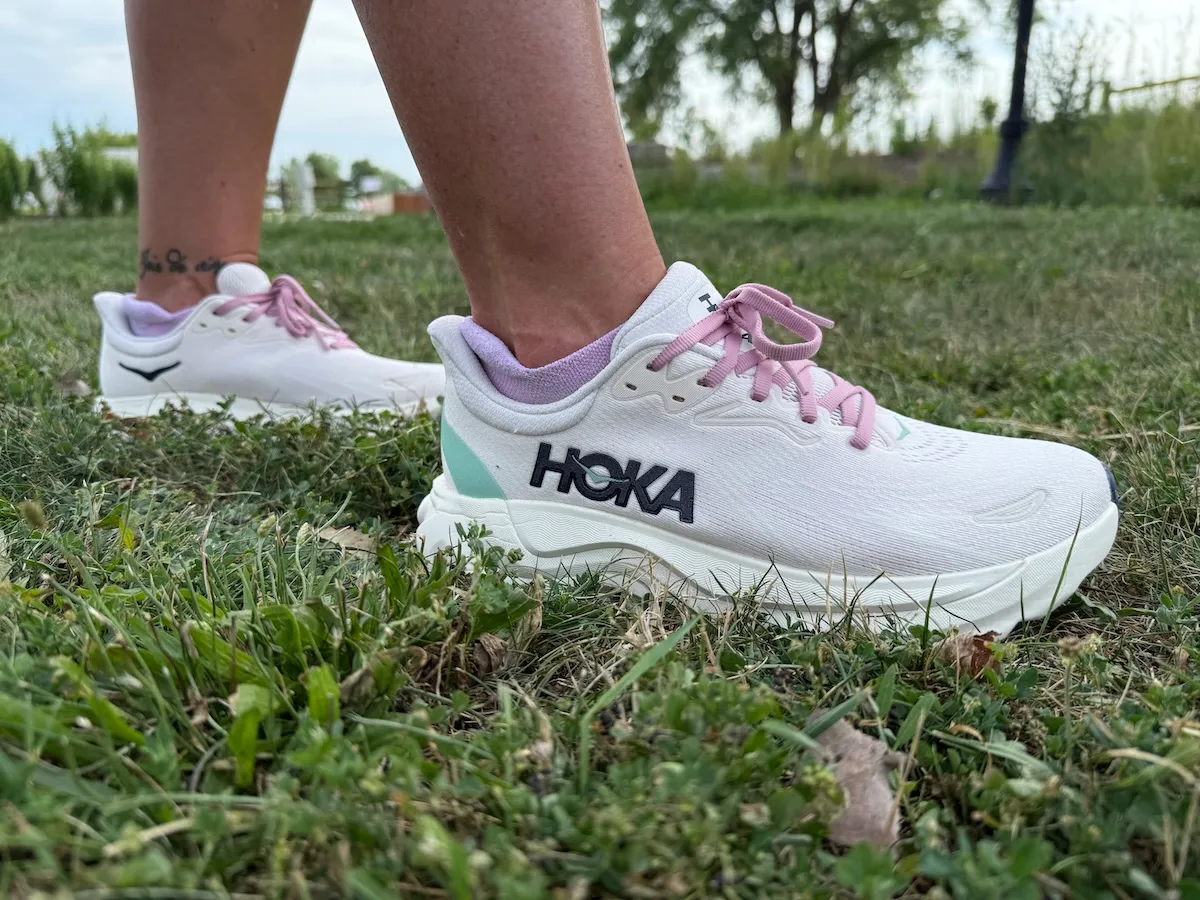
This shoe is great for easy and long training runs, especially with extra space in the toebox.
Even with an additional 3mm of foam from previous models this shoe felt light and had a little bounce to it— if you’re someone who needs a lot of support and prefers a more rigid shoe, this might not be the choice for you.
- Weight: 9.8 oz Men’s, 7.7 oz Women’s
- Stack Height: 39 mm
- Heel Drop: 8 mm
- Available in 6 colors
- Available in wide and extra wide
- Available on hoka.com for $150.00
- Check out our full review of the Hoka Arahi 8 here >>
Neutral Running Shoe
👉Asics Novablast 5
The Novablast has been a winning max cushion shoe from Asics since it first launched and they have continued to increase the amount of cushion in the shoe, while working to drop the weight. It’s not going to be the plush shoe you’ll see below, but it’s a great amount of cushion in a weight that’s going to translate to a lot of miles for the average runner from training even to race day.
The 5 has a completely new full length midsole with their FF Blast Max foam. Again, I like that this shoe is a more responsive cushion and you don’t sink in to it so much.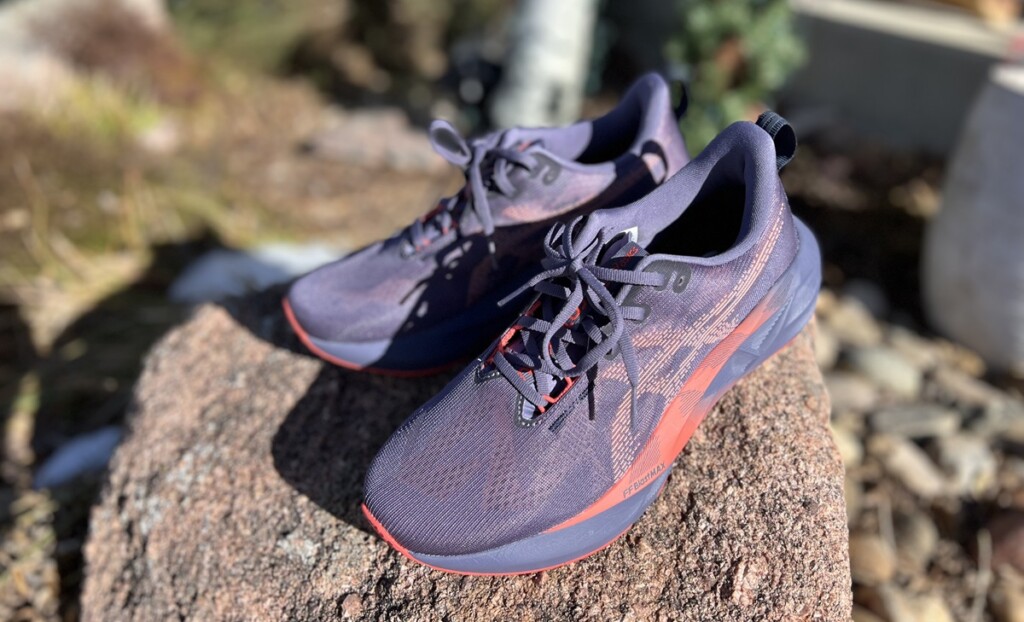
While this is a neutral shoe, with no guiderails or anything for stability, it absolutely has some of that built in to the design. The width of the platform from toe to heel reduces pronation and provides a really good ride.
- Weight: 7.9 oz women’s, 9.1 oz men’s
- Heel toe drop: 8mm
- 8 colors available
- Not available in wide
- Available at RunningWarehouse.com and Asics.com for $160
- Read my full review of the Asics Novablast 5 here>>
👉Hoka Clifton 10
If you need 1 shoe for both walking workouts, standing or your feet or even a run, then this is the pick.
It’s not as soft as the previous ones, but still has plenty of cushion to be on your feet, along with the support to keep you in good alignment while standing.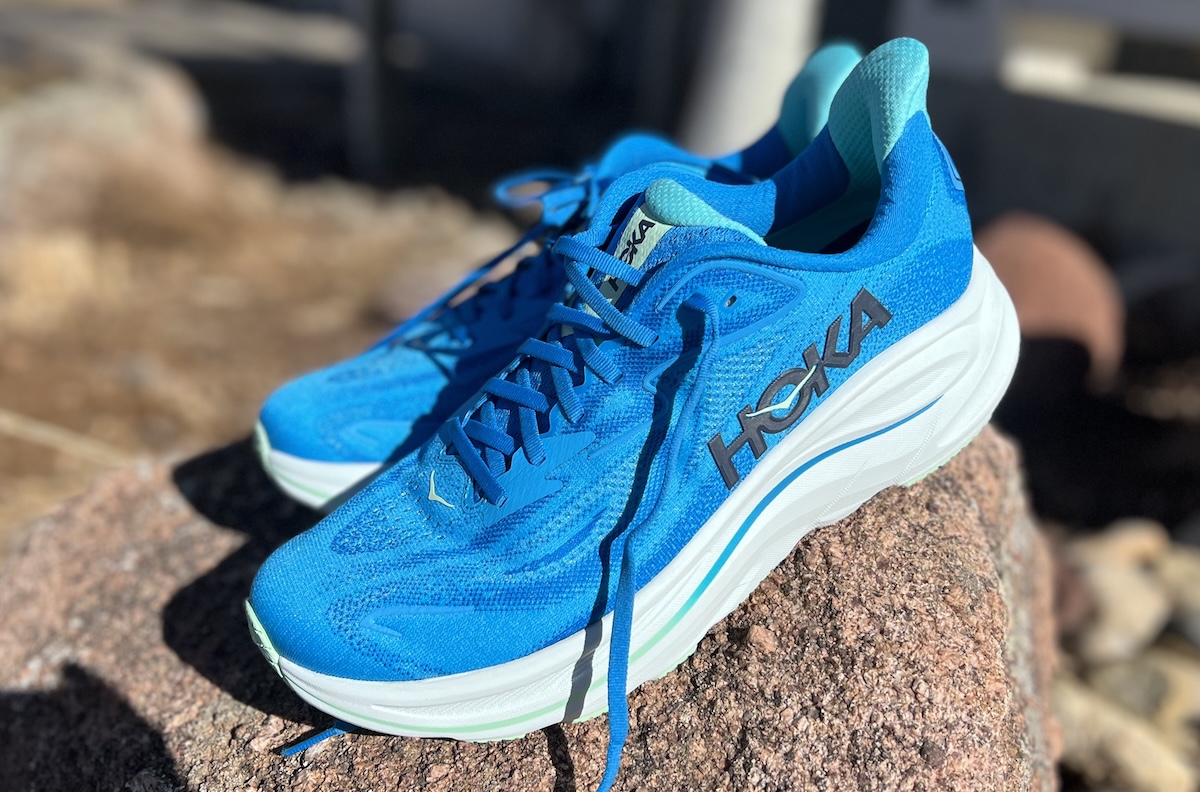
The shoe also has a lightweight design, which makes it ideal for those who are looking for a shoe that won’t feel too heavy (most walking shoes are heavier). Truly not always easy to find a combination of cushion and low weight!
The Clifton also has a breathable engineered mesh upper, which helps to keep the feet cool and dry, making it a good option for workout out in hot and humid conditions.
- Weight: 9.8 oz men’s, 8.0 oz women’s
- Heel drop: 8mm
- 14 colors available
- Available in Wide in some colors
- See all sizes and widths on Hoka.com for $150
- Read our detailed Hoka Clifton 10 review >>
Cushioned Running Shoe
👉ASICS GEL Nimbus
This shoe will appeal to most runners looking for a neutral fit and some MAX Cushion.
This is the plushest shoe in their line up with a great big old stack height and we’re here for it. The most recent model feels like a great update to a shoe that will carry a lot of runners over long miles with foam that’s durable and a fit that isn’t overly soft.
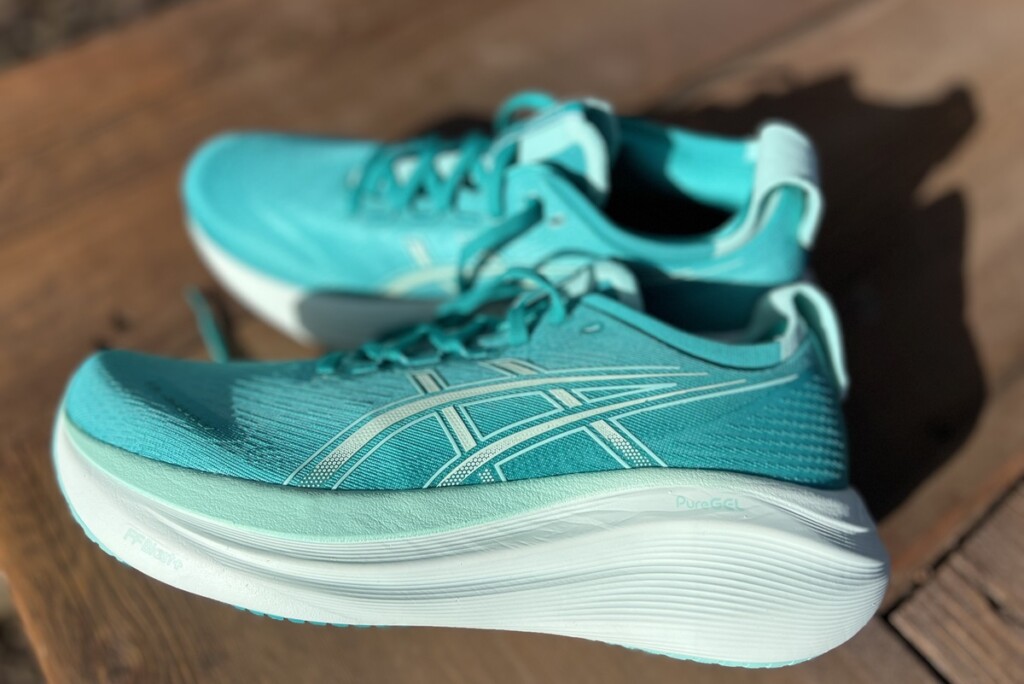 With the 42mm stack height, they did manage to retain a feeling of stability. The firmness that I wasn’t a huge fan of with the last one (because why should a max shoe feel firm) is gone and now it’s just a big cushioned ride. For me personally, I can’t say it’s a shoe I’d wear for anything other than easy runs. I certainly wouldn’t turn to it for tempo work or a race where a PR is the goal.
With the 42mm stack height, they did manage to retain a feeling of stability. The firmness that I wasn’t a huge fan of with the last one (because why should a max shoe feel firm) is gone and now it’s just a big cushioned ride. For me personally, I can’t say it’s a shoe I’d wear for anything other than easy runs. I certainly wouldn’t turn to it for tempo work or a race where a PR is the goal.
- Weight: 10.7 oz Mens, 9.2 oz Women’s
- Heel Drop: 8mm
- 4 colors available
- Not available in wide
- Available at Asics.com for $160
- See our full Asics Gel Nimbus 27 review >>
👉Hoka Bondi 9
The Hoka One One Bondi is great for everyday running and walking. With its max cushioning, it’s almost guaranteed to provide max comfort too. The one thing to remember is that the more cushion, the less “pop” or speed you’ll get from a shoe.
I think this is really ideal for our heavier runners, those who are doing 5+ hour marathons and want some soft lasting cushion.

The newest model has a mesh construction, lighter foams, and an extended heel that offers a soft but balanced roll-through from heel strike to push-off. Just remember as we mentioned before that more cushion isn’t always better.
So this for me is one of the shoes in my rotation for recovery runs, but not for everyday.
- Weight: 10.5 oz Men’s, 9.3 oz Women’s
- Heel Drop: 5 mm
- 6 colors available
- Available in wide
- Available on Hoka.com for $170
- Checkout our complete Hoka Bondi 9 review >>
Carbon Fiber Plate Shoes
Are they cool new technology, yes. Do they last as long as your other shoes, nope.
So if you want to test these out use them for speed work and then race day!
👉 Hoka Cielo X1 2.0
The Cielo X1 2.0 is built for speed demons chasing PRs.
With an aggressive forefoot rocker, lively dual-density PEBA foam, and an updated winged carbon fiber plate, this shoe doesn’t just ask you to pick up the pace—it dares you.
But with the speed gains comes a trade-off: stability takes a hit, making this version less forgiving for runners who need more support. If you loved the original for its balance of speed and control, this update might feel like a different beast altogether.
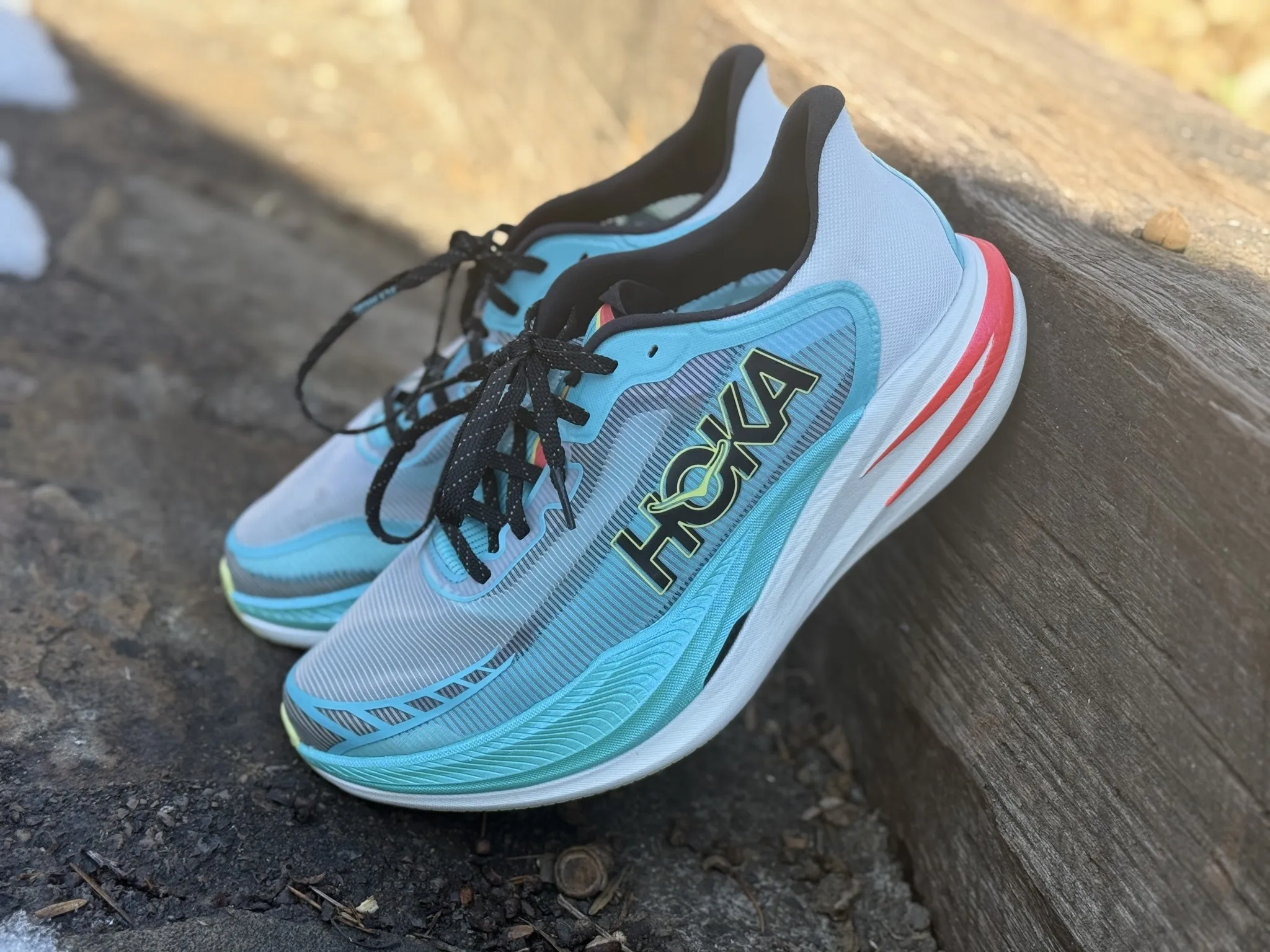
This is definitely a shoe that can take you sub 1:30:00 in the half marathon or under 3:00:00 for a marathon.
- Weight: 8.1 oz Men’s, 6.8 oz Women’s
- Heel drop: 7 mm
- 1 color available
- Not available in wide
- Available from hoka.com for $275
- See our complete HOKA Cielo X1 2.0 review here >>
BONUS: If you’re more middle or back of the pack, they are catering to your needs too with the new Hoka Skyward X. It’s super fun ride and I really recommend.
👉ASICS Metaspeed Sky
The Metasped Sky is a maximum cushioned carbon fiber plate for the marathon runner in you. It’s going to give you both that feeling of comfort over the miles along with the pop that’s often lost in a highly cushioned shoe.
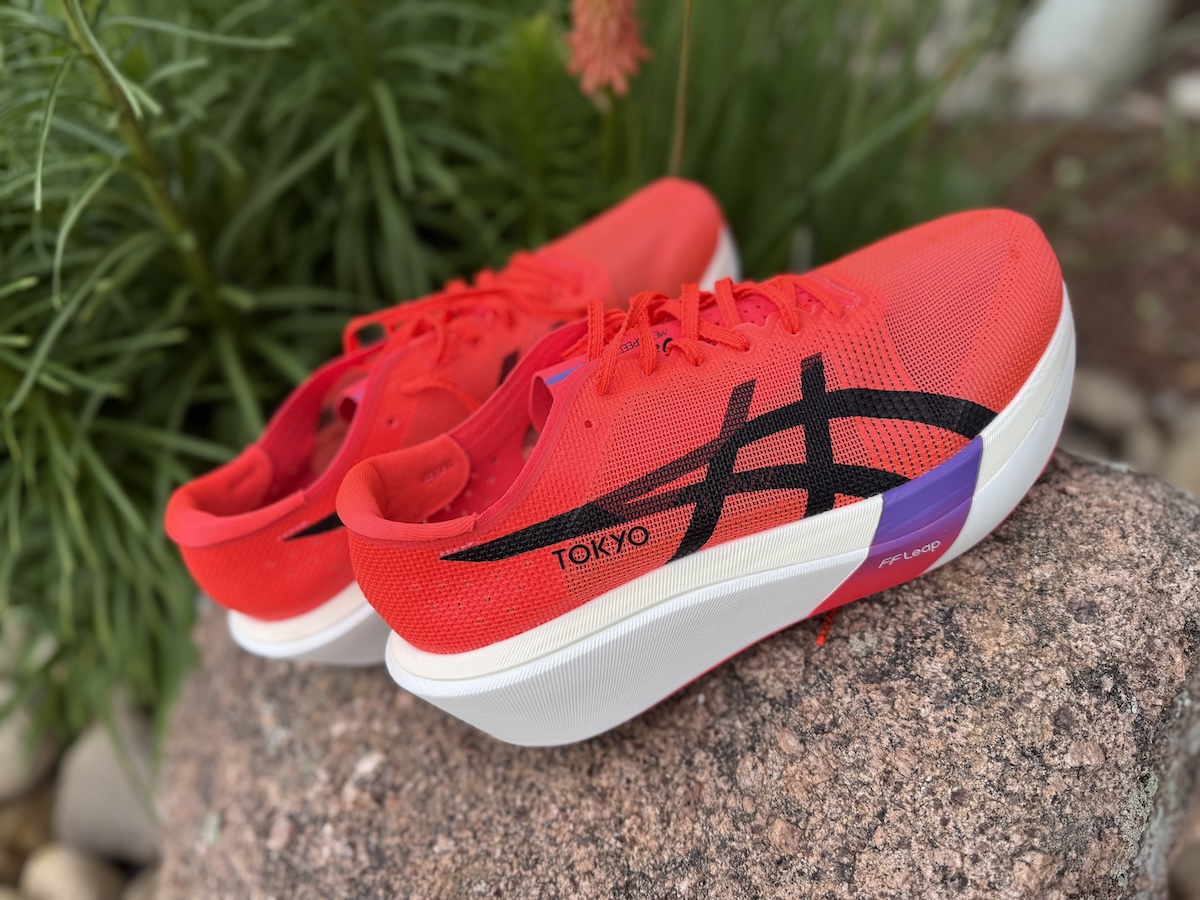
We did find that like many carbon plated shoes it doesn’t feel super stable, so if you have any ankle issues or need that wider base probably not a good fit. It’s also most ideal for the front of the pack forefoot to midfoot strikers.
It’s not a back of the pack speed shoe, you won’t get the benefits because your gait is different.
A go-to pick for speed workouts and marathon efforts
- Weight: 5.9 oz (unisex)
- Stack Height: 39.5 mm
- Heel Drop: 5 mm
- Limited launch colors
- Not available in wide
- Available on Asics.com for $270
- Check out our full review of the Asics Metaspeed Sky Tokyo vs Edge here >>
Watch my detailed video on how Carbon Fiber Shoes work.
More About ASICS
Founded in 1949, by Kihachiro Onitsuka in Japan, ASICS is an acronym for the Latin expression “Anima Sana in Corpore Sano” (“healthy mind in a healthy body”).
The company released a basketball shoe in 1950, followed by running shoes in 1953. Among those running shoe products included the Onitsuka Tiger, still a popular shoe today, though mainly used as a casual shoe as opposed to a marathon shoe.
Today, ASICS designs a wide variety of shoes including: running, tennis, volleyball, wrestling, and golf.
Fun fact: Nike was founded to sell the Onitsuka Tiger shoes in the US. After visiting Japan in 1963, Phil Knight was impressed by the high quality and reasonable prices and asked the company to represent the brand in the US. Anyone else read his book and find all of this fascinating?!
Your gait and feet will likely change over time and you may need to change shoes.
This is also why I recommend rotating through several pairs of shoes at once.
And remember, just because these are two of the most well known brands on the market, there are still plenty of other shoe brands to select from if neither ASICS nor HOKA has the right shoe for you.
Keep in mind that shoe design can change, even with the same model, so always assess how the shoe fits every time you replace a pair.
More about HOKA ONE ONE
Let’s start with how do you pronounce Hoka One One? “Ho-Kah O-nay O-nay” which is a Māori phrase that means “to fly over the earth.”
But they’re kind of like Madonna and just need one name: Hoka.
Founded by two mountain trail runners in the Swiss Alps, Nicolas Mermoud and Jean-Luc Diard, former Salomon employees, had an epiphany during their training that lead to the foundation of a new shoe and new company in 2009.
This makes them a mere baby in the world of running shoes, as many of the brands from Brooks to ASICS have been around 100+ years now. Pictured here is their first prototype.
At first they simply wanted a shoe that would allow them to run downhill faster and thus win!
Quickly they realized there was something more here with a smooth, super light, cushioned and stable shoe. Their maximal design took many of by surprise in a time where Zero Drop and Barefoot running were the in thing.
In 202o, the company was purchased by Deckers (owners of UGG and Teva). Hopefully that just means more marketing to keep the shoes going and not a change to what their doing right.
For more help selecting the right shoe for you, don’t worry, I’ve got you:
- Nike Vs New Balance running shoes
- Best Trail Running Shoes
- Top 5 Marathon Running Shoes
- Best Running Shoes
- Saucony vs Brooks
Other ways to connect with Amanda
Instagram Daily Fun: RunToTheFinish
Facebook Community Chatter: RunToTheFinish
Sign Up to Receive a Weekly Newsletter with Top Running Tips and Laughs



 Hoka Clifton Vs Mach | Which Neutral Cushioned Trainer To Pick?
Hoka Clifton Vs Mach | Which Neutral Cushioned Trainer To Pick?